You can establish many fodder trees that you need to feed your animals by planting seeds directly;
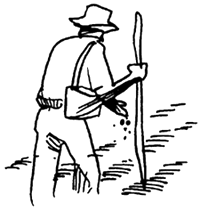
or by using seedlings that you first need to raise yourself. We shall see later how to raise seedlings;

or by using cuttings of stems or stakes (Gliricidia). If you plant from stems, you may need a lot of stem cuttings. For example, you may need up to 25 tonnes of stem cuttings to plant an alley farm of Gliricidia with the tree rows spaced 4 metres apart as shown.

If you plant from seeds or seedlings, you will first need to obtain the seeds. How can you get all the seeds you need?
For trees such as mesquite, you can collect ripe pods that fall naturally, sun-dry them and remove the seeds as already described. You can get as many as 15–25 seeds in each pod. Using pods weighing about 5 g, if you collect 1 kg pods, you will get about 200–300 pods, that is, about 3 000–7 500 seeds, and sometimes many more.
For trees such as Leucaena, you can leave the pods to mature on the tree. Harvest when yellow, not when too mature and dark brown, to reduce seed losses through shattering and insect damage.
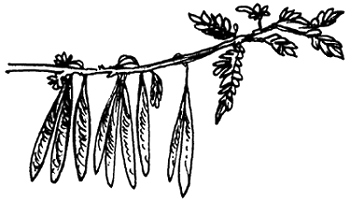
For other trees such as Gliricidia, you should not let the pods dry on the tree, or they may shatter and a lot of seeds will be lost. Harvest the pods before they are dry and then dry them in the sun in a container.

You can also produce seeds on a small portion of your land, for your own use, or to sell or give to other farmers. For Gliricidia and Leucaena, for example, fence a small portion of your land and plant the seeds in rows (2×2 metres).
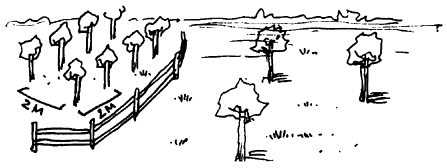
Your Leucaena plant may flower after nine months and produce mature pods about eight months later. The pods contain 15–25 seeds each. If you collect 1 kg of pods, you will get about 20 000 seeds.
Gliricidia is a bit slower, and may flower after 18 months, to produce pods three months later. For seed production purposes, do not cut the plants too often, preferably once, and do not harvest seeds in the rainy season.
If you do not plant seeds immediately after collection, you need to store them properly, so that they are not damaged by insects and moulds. The first thing is to make sure they are properly dried: dry your seeds for three to five days in the sun.

Then store them in airtight containers such as glass bottles or plastic bags. First put some material in the container that can absorb water, like dry wood, ash, charcoal, lime, newspaper, dry rice hulls, etc., then fill the rest of the container with the seeds, in order, to leave no space for air.

Some of these materials such as wood ash not only absorb water, but also protect the seeds from insect attacks. You can also use any kind of vegetable oil.

For wood and/or cow dung ash, burn the wood or dry cow dung, let the ash cool down, and mix with seeds, using one part of ash to 200–300 parts of seeds, and store in an airtight container in a cool dry place, or in a refrigerator if you have one.

Another way to get seeds is to buy from good sources. You can ask the following organizations: NFTA (Nitrogen Fixing Tree Association), ICRAF (International Centre for Research in Agroforestry), IITA (International Institute of Tropical Agriculture), to direct you to good suppliers near you, or even give you some seeds. See the end of this manual for addresses.
Many fodder tree seeds have hard seed coats that slow down and reduce the germination rate. If you want to get high and rapid germination of planted seeds, you must treat them in one of the ways already described and shown again below.
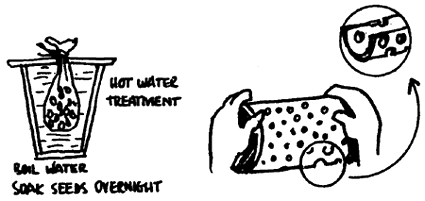
Remember that when you plant fodder trees, either by direct seeding or through seedlings, you must take care of them just like your food crops.
After clearing the land, sow seeds 2–3 cm deep
 | in shallow furrows |
| in individual holes |
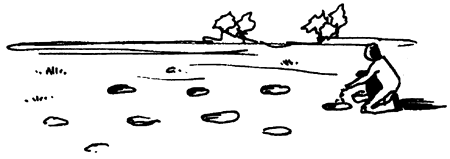
or even under growing food crops such as maize.
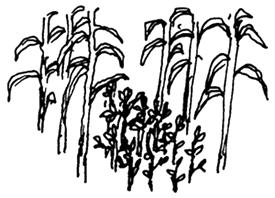
Many trees such as mesquite and acacia can grow in soils of low fertility, but you still need to fertilize them just as you fertilize your crops for good establishment and growth. You can use animal manure, or find out which type of fertilizer is suitable for your area.
Remember also that some trees, called leguminous trees, such as Prosopis, Faidherbia and Leucaena can take nitrogen from the air and turn it into nitrogen that the tree can use to grow, so you may not need to fertilize the tree with nitrogen.
It is not the tree itself that makes this nitrogen available, but bacteria living on its roots. These bacteria are called rhizobia.

Sometimes, these rhizobia may not be present in the soil where you plant your trees, so they do not get this extra nitrogen. This happens when you plant a particular leguminous tree for the first time in your area or on your farm. If your seedlings grow too slowly and the leaves become yellow, it may be because the rhizobia for that tree are not present in your soil.
So, when you first plant a particular leguminous tree on your farm, you should “inoculate” the seeds before planting. That means you have to cover the seeds with the rhizobia.
How can you inoculate your seeds? Collect some soil from under the same type of trees growing nearby and mix the soil with your seeds before you plant them. You can put some of the soil in the planting holes or furrows.
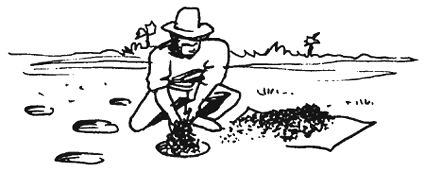
Another way is to buy the special rhizobia you need for your tree from the people who make them, to use on your own farm. (See the end of this manual for addresses.)
Mix the rhizobia with your seeds as follows: prepare a gummy or sticky solution such as gum arabic by mixing one part of gum arabic with two and a half parts of hot water in a bucket, and allow to cool,
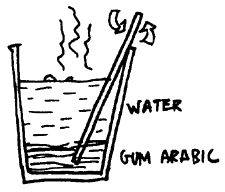
or use a sugar solution and mix one part of sugar and two parts of water.

Mix seeds with the gummy solution:
one part of gum arabic plus 25 parts of seeds; or
one part of sugar solution plus 100 parts of seeds;
or one part of vegetable oil plus 50 parts of seeds.
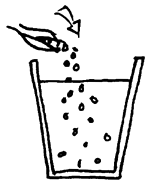
Add one part of the rhizobia to 20 parts of the wet seeds and mix well in a bucket or in a plastic bag.
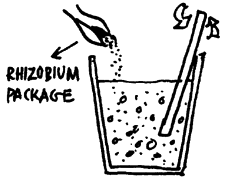
Dry the seeds under shade for a while and plant. Sometimes it may be better to raise plants as seedlings and then transfer them to the field some months later when they are strong enough to survive.
You can use different kinds of containers to plant the seeds: plastic bags, cardboard boxes or pots.

Make holes in the containers so that water does not accumulate at the bottom, keep them under shade, not in direct sunlight, water regularly, and protect them from animals. Move the containers around from time to time, to prevent the roots of the seedlings from going into the soil.
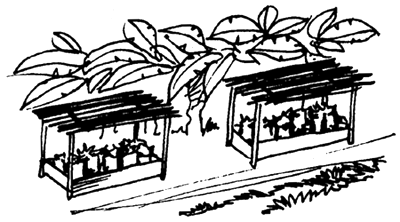
Depending on the type of tree, you can plant the seedlings in the field after four to six months, at the beginning of the rainy season.
If you take good care of your trees, you will get a lot of fodder for feeding your animals for many years. However, insects and other pests may attack your trees. Treating the soil or trees with insecticides may remove these insects. Planting different types of trees is also a good way to make sure all your trees do not get destroyed by insects. For example, the jumping lice that attack Leucaena will not destroy Gliricidia or pigeon pea, so these trees are safe when Leucaena is attacked.